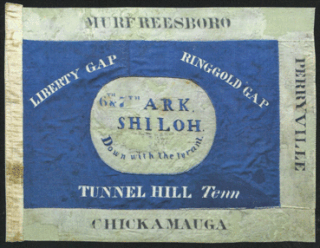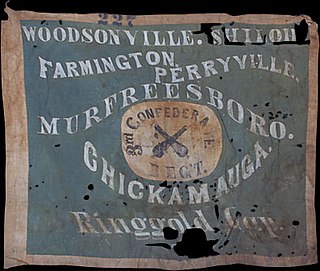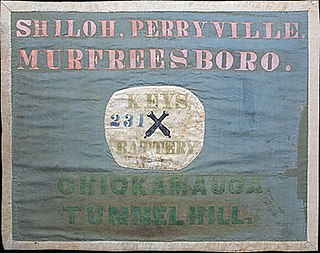Related Research Articles
1st Arkansas Mounted Rifles (1861–1865) was a Confederate States Army cavalry regiment during the American Civil War. The unit was formed as a mounted infantry regiment, but was dismounted in the spring of 1862 and remained dismounted for the remainder of the war. The unit participated in the earliest battles in the western theater at Wilson's Creek and surrendered with the remnants of the Army of Tennessee in North Carolina in April 1865.
2nd Arkansas Light Artillery, (1860–1865) was a Confederate Army artillery battery which served during the American Civil War. The battery spent the majority of the war serving in Confederate forces east of the Mississippi River. The battery is also referred to as the Clark County Artillery, Robert's Arkansas Battery and Wiggins Arkansas Battery.
The 30th Ohio Infantry Regiment was an infantry regiment in the Union Army during the American Civil War.
Frederick Ernest Toy was a soldier in the U.S. Army during the Indian and Spanish–American Wars; During his enlisted service, he was assigned to the 7th Cavalry Regiment until promoted to ordnance sergeant and served at a variety of posts. He received the Medal of Honor for bravery at the Battle of Wounded Knee, but now called the Wounded Knee Massacre, against the Dakota Indians on December 29, 1890. Toy retired from the Army in 1910. He was recalled and commissioned as a captain during World War I. He worked as an employment manager and as a railroad police officer.

The units of the Arkansas Militia in the Civil War to which the current Arkansas National Guard has a connection include the Arkansas State Militia, Home Guard, and State Troop regiments raised by the State of Arkansas. Like most of the United States, Arkansas had an organized militia system before the American Civil War. State law required military service of most male inhabitants of a certain age. Following the War with Mexico, the Arkansas militia experienced a decline, but as sectional frictions between the north and south began to build in the late 1850s the militia experienced a revival. By 1860 the state's militia consisted of 62 regiments divided into eight brigades, which comprised an eastern division and a western division. New regiments were added as the militia organization developed. Additionally, many counties and cities raised uniformed volunteer companies, which drilled more often and were better equipped than the un-uniformed militia. These volunteer companies were instrumental in the seizure of federal installations at Little Rock and Fort Smith, beginning in February 1861.
The 13th Arkansas Infantry (1861–1865) was a Confederate Army infantry regiment during the American Civil War. Organized mainly from companies, including several prewar volunteer militia companies, raised in northeastern Arkansas, the regiment was among the first transferred to Confederate Service, and spent virtually the entire war serving in Confederate forces east of the Mississippi River. After the unit sustained heavy casualties during the Battle of Murfreesboro, the unit spent most of the rest of the war field consolidated with the 13th Arkansas Infantry Regiment, to form the 5th/13th Arkansas Infantry Regiment.

The 7th Arkansas Volunteer Infantry (1861−1865) was a Confederate Army infantry regiment during the American Civil War. Organized mainly from companies, including several prewar volunteer militia companies, raised in northeastern Arkansas, the regiment was among the first transferred to Confederate service, and spent virtually the entire war serving east of the Mississippi River. After the unit sustained heavy casualties in the Battle of Shiloh and the Kentucky Campaign, the unit spent most of the rest of the war field consolidated with the 6th Arkansas Infantry Regiment to form the 6th/7th Arkansas Infantry Regiment.

8th Arkansas Infantry Regiment was an infantry formation in the Confederate States Army during the American Civil War. It served throughout the war in the western theater, seeing action in the Kentucky, Tennessee and Georgia campaigns. Following its depletion in numbers the regiment was consolidated several times with other Arkansas regiments, finally merging in 1865 into the 1st Arkansas Consolidated Infantry Regiment.

The 25th Arkansas Infantry was an infantry regiment of the Confederate States Army during the American Civil War. The unit was originally organized as Turnbull's 11th Arkansas Infantry Battalion. Upon being increased by the required number of companies the battalion was organized as the 30th Arkansas Infantry Regiment but was later redesignated as the 25th Arkansas Infantry. There were two regiments officially designated as the 30th Arkansas Infantry. The other "30th Arkansas" served west of the Mississippi River, in the Department of the Trans-Mississippi and was also known as 5th Trans-Mississippi Regiment or the 39th Arkansas or Rogan's Arkansas Cavalry during Price's 1864 Missouri Expedition.

The 27th Arkansas Infantry Regiment (1862–1865) was a Confederate Army infantry regiment during the American Civil War. The unit served entirely in the Department of the Trans-Mississippi and surrendered at Marshall, Texas, at the war's end.
The 15th Arkansas Infantry Regiment or Josey's Arkansas Infantry Regiment was an infantry formation in the Confederate States Army during the American Civil War. The regiment was organized in May 1861 under the command of Colonel Patrick Cleburne. It served throughout the war in the western theater, seeing action in the Kentucky, Tennessee, and Georgia campaigns. Following its depletion in numbers the regiment was consolidated several times with other Arkansas regiments, finally merging in 1865 into the 1st Arkansas Consolidated Infantry Regiment. There were two other regiments which also received the designation of "15th Arkansas". The 21st (McRae's) Arkansas Infantry was redesignated 15th Arkansas in February 1863, but to avoid confusion, was normally referred to as the "Northwest regiment". This second "15th Arkansas" was surrendered at Vicksburg in July 1863. A third regiment, under command of Colonels Gee and later Johnson, also received the designation 15th Arkansas Infantry. This last regiment surrendered at Port Hudson, Louisiana, in July 1863.

The 18th Arkansas Infantry (Marmaduke's) (1861–1865) was a Confederate Army infantry regiment during the American Civil War. The unit was also briefly identified as the 1st Arkansas Infantry Battalion. The unit was most often referred to as the 3rd Confederate Infantry Regiment. The designation "Confederate Infantry Regiment" was intended to convey the difference between Provisional Confederate Army units and Regular Confederate Army Units, with Provisional units being those regiments who received a state designation such as "XX Arkansas Infantry Regiment". In practice, the designation was most often utilized when Regiments were assembled utilizing companies from more than one Confederate state. The "3rd Confederate Infantry Regiment" is occasionally misidentified as the 3rd Arkansas Infantry Regiment commanded by Colonel Van H. Manning.
The 12th Arkansas Infantry (1861–1865) was a Confederate Army infantry regiment during the American Civil War. The regiment spent much of its service defending Confederate strong points along the Mississippi River. The unit participated in the defense of Island No. 10 in early 1862 and later became part of the garrison of Port Hudson in 1863. Following the capitulation of the garrison of Port Hudson, the survivors of the 12th were eventually paroled and exchanged back to Arkansas where the regiment was consolidated with the remnants of several other Arkansas regiments to become the 2nd Arkansas Consolidated Infantry Regiment.
The 1st Arkansas Light Artillery, originally known as the Fort Smith Artillery (1861), was an artillery battery of the Confederate States Army that served during the American Civil War. The unit was actually a pre-war volunteer militia company which was activated as part of the Arkansas State Troops and mustered out of state service following the Battle of Wilson's Creek. The unit immediately re-organized and re-enlisted for Confederate service. The unit spent the majority of the war in the western theater, fighting as part of the Confederate Army of Tennessee. The unit is also known as Reid's Battery, Provence's Battery, Humphreys' Battery and finally Rivers' Battery.

The 2nd Arkansas Field Battery (1861–1865) was a Confederate Army artillery battery during the American Civil War. Also known as: Dallas Artillery and Hart's Arkansas Battery. The battery was re-organized on two occasions. Following a charge of cowardice during Battle of Pea Ridge, the battery was ordered to disband. After being cleared of that charge the battery was reorganized and served until it was captured at the Battle of Arkansas Post. After being exchanged and re-organized for the second time, it served until the final surrender of Confederate forces in May 1865.
The Brown's Arkansas Artillery Battery (1862–1863) was a Confederate Army artillery battery during the American Civil War. Also known as: the Newton Artillery. The battery operated in the Confederate Department of the Trans-Mississippi for its entire existence.

Charles Constantine Crews was an attorney, physician, railroad executive and Confederate Colonel in the American Civil War. Between 1862 and 1865, he participated in most of the Western Theater cavalry campaigns of Major General Joseph Wheeler, initially leading the 2nd Georgia Cavalry and eventually a cavalry brigade.
The following Confederate States Army units and commanders fought in the Third Battle of Winchester on September 19, 1864. The Union order of battle is listed separately. The battle was fought on September 19, 1864, near Winchester, Virginia, and Opequon Creek. The battle is also known as the Battle of Opequon or the Battle of Opequon Creek.

The 1st Pennsylvania Reserve Regiment, also known as the 30th Pennsylvania Volunteer Infantry, was a regiment in the Union Army during the American Civil War. It was a part of the famed Pennsylvania Reserve division in the Army of the Potomac for much of the war, and served in the Eastern Theater in a number of important battles, including Antietam, Fredericksburg, and Gettysburg.

The Helena Artillery (1861–1865) was a Confederate Army artillery battery during the American Civil War. The unit was known by several other designations during the war including Clarkson's Battery, Company A, Shoup's Artillery Battalion, Calvert's Battery, and Key's Battery. The unit was occasionally assigned to artillery battalions from other states, so the Arkansas unit was at various times designated as Company C, 20th Alabama Light Artillery Battalion and later as Company H, 28th Georgia Artillery Battalion.
References
- U.S. War Department, The War of the Rebellion: a Compilation of the Official Records of the Union and Confederate Armies, U.S. Government Printing Office, 1880–1901.
- National Archives and Records Administration. "Inspection Reports and Related Records Received By The Inspection Branch in the Confederate Adjutant and Inspector General's Office".
- Index to NARA Microfilm M935, Reel 10: Inspection Reports P-12 to 39-P-24.